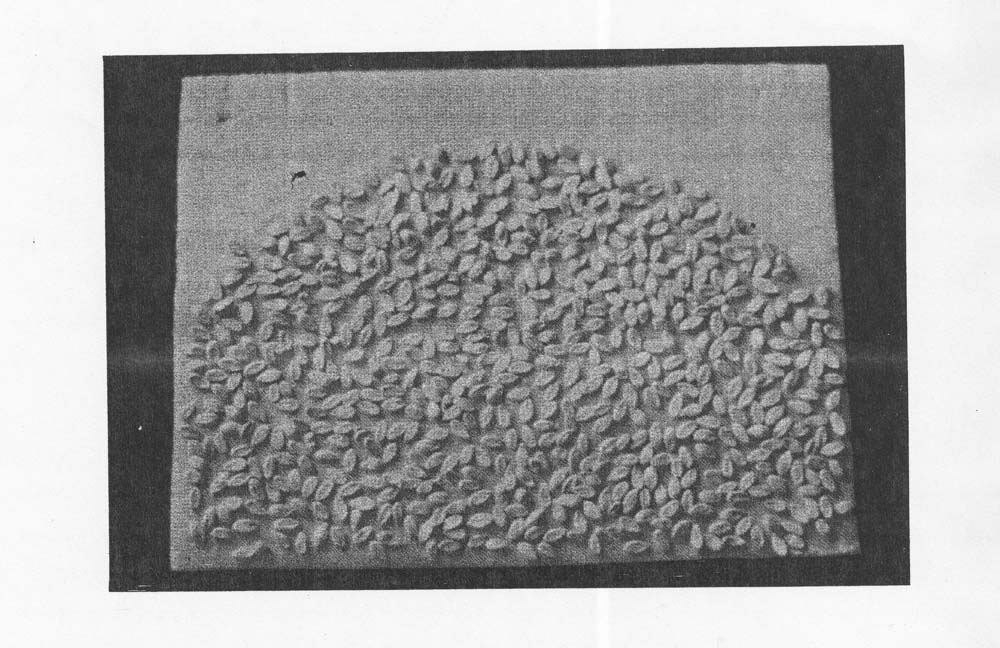Cucurbit Genetics Cooperative Report 11:39-42 (article 18) 1988
F. Savin
Ecole Nationale Supeieure d’Horticulture de Versailles, France.
V. Decombie, M. Le Couviour, J. Hallard
L. Clause S.A. Research and Development Station, Saint Remy de Provence, France.
The utilization of haploids or doubled haploids is very important in the field of plant breeding. Several authors have reviewed the subject; among them, Jensen (3) gave a status on the induction and production of haploids or doubled haploids in crop plants, underlined results enabling relatively stable production of haploids and gave information on chromosome doubling techniques (1).
In muskmelon, spontaneous haploids have only very rarely been observed. Dumas de Vaulx (2) attempted to produce individual haploids by Interspecific crossing. Crossing of Cucumis melo L. X Cucumis ficifolius (4X) following removal of the stigma enabled the pollen tube to reach the enabled embryo sac. In order to induce the development of the fruit, a second fertilization by Cucumis melo was performed. A few haploid embryos have been thus obtained, but the rate was always low and highly dependent on the genotype. More recently, the seed companies Clause and Limagrain decided, in collaboration with INRA in the frame of a “Group of Economic Interests” to finance a new project. The work was carried out by A. Sauton in 1985 and 1986 and the results published in 1987 (3).
The anther and ovule cultures have never enabled a complete embryogenesis. The results obtained by utilizing irradiated pollen seem to offer greater possibilities of success compared to previous attempts. The method of parthenogenesis induced in situ has been worked out by Raquin (4) on petunia. It consists of inducing the development of haploid embryos by making a deposit of pollen which has been denatured by gamma rays (Co 60). Despite treatment, the germinative abilities and the fertilizing power are preserved, whereas the chromosomic stock is destroyed. The deposit of irradiated pollen is made on the day of anthesis of the female flowers. Usually, the treated flowers grow normally nd fruits can be picked three weeks after hand pollination. It is essential to transfer the rare haploid embryos that have been induced to an in vitro culture medium; otherwise they dry up and degenerate rapidly.
The classical method of embryo detection consists of opening each seed by hand. This operation is a very long and delicate one, requiring many hours of work for a very small number of saved haploid embryos. So, we had the idea of utilizing an X-ray process, a technique which is already wide-spread for analyzing the quality of dry seeds (1), in order to detect the haploid embryos. We have found that the medical X-ray machine which gave positive results was the one used for mammography, as the other types of machines do not give a clear film.
Preparation of the seeds: X-rays are only efficient to discriminate four- to seven-week old embryos in the seeds. At a younger stage, embryos can not be detected. On the other hand,beyond seven weeks, the embryos’ germination dwindles considerably and there are great losses of material.
For X-ray detection of young embryos, an adequate desiccation of the seed is needed. If the seeds contain too much water, they appear opaque on the film, and it is impossible to observe their internal part. On the other hand, they must not be too dry otherwise the embryo may be desiccated and destroyed.
The layout of the seeds on their base: The seeds are laid on an extruded polystyrene plate (5 mm thickness) covered by a sheet of transparent adhesive plastic. They are spread out flat and touching each other on the X-ray surface.

The X-ray operation: The characteristics of the X-ray are:
- Exposure time: 1 second
- Penetration: 18 kvolts
- Flow 35 to 70 mA according to the size of the seeds.
The mamography machine must be focused so as to be just over the seeds. By proceeding in this way, we have been able to rapidly detec (6) the seeds which actually contain a haploid embryo.
The X-ray film enables a considerable saving of time. It is thus possible to treat a much greater number of fruit and therefore envisage a higher production of haploid embryos. On the other hand, the x-ray film enables the determination of the location, as well as the shape and the size of the embryo.

Consequently, opening of the seeds is a less delicate operation.
Apart from the extension to the Cucurbit family, this technique for detecting haploid embryos can also find an interesting application in identifying the rare diploid embryos derived from interspecific crossings which require an in vitro culture for further development.
Literature Cited
- Chavagnat, A. Determination de la qualite des semences horticoles par radiographic industrielle aux rayons X. P.H.M. 249:57-61.
- Dunas de Vaulx, R. 19791. Obtention de plantes haploides chez le melon (Cucunmis melo L.) apres pollinasation par Cucumis ficifolius A. Rich. C.R. Acad. Sc., Paris, t 289 serie D, 875-878.
- Jensen, C.J. Haploid induction and production in crop plants. In Genetic Manipulation in Plant Breeding. Proc. Int. Symp. EUCARPIA, Sept. 8-13, 1985, Berlin (West), Germany. Ed. Walter de Gryuyter, Berlin – New York, 1986.
- Raquin, C. 1985. Induction of haploid plants by in vitro culture of Petunia ovaries pollinated with irradiated pollen. Z. Pflanzenzuchtung 94:166-169.
- Sauton, A. 1987. Recherche d’haploides chez le melon (Cucumis melo L.). Etude et application a la selection de la parthenogenese induite par du pollen irradie. These nouveau regime. Universite des sc. et techn. du Languedoc, Montpelier – France.
- Savin, F. 1987. Contribution a l’emploi de l’haplodiplomethode dans les programmes de selection du melon (Cucumis melo L.) Memoire d’ingenieur – Ecole Nationale Superieure de’Horticulture, Versailles – France.